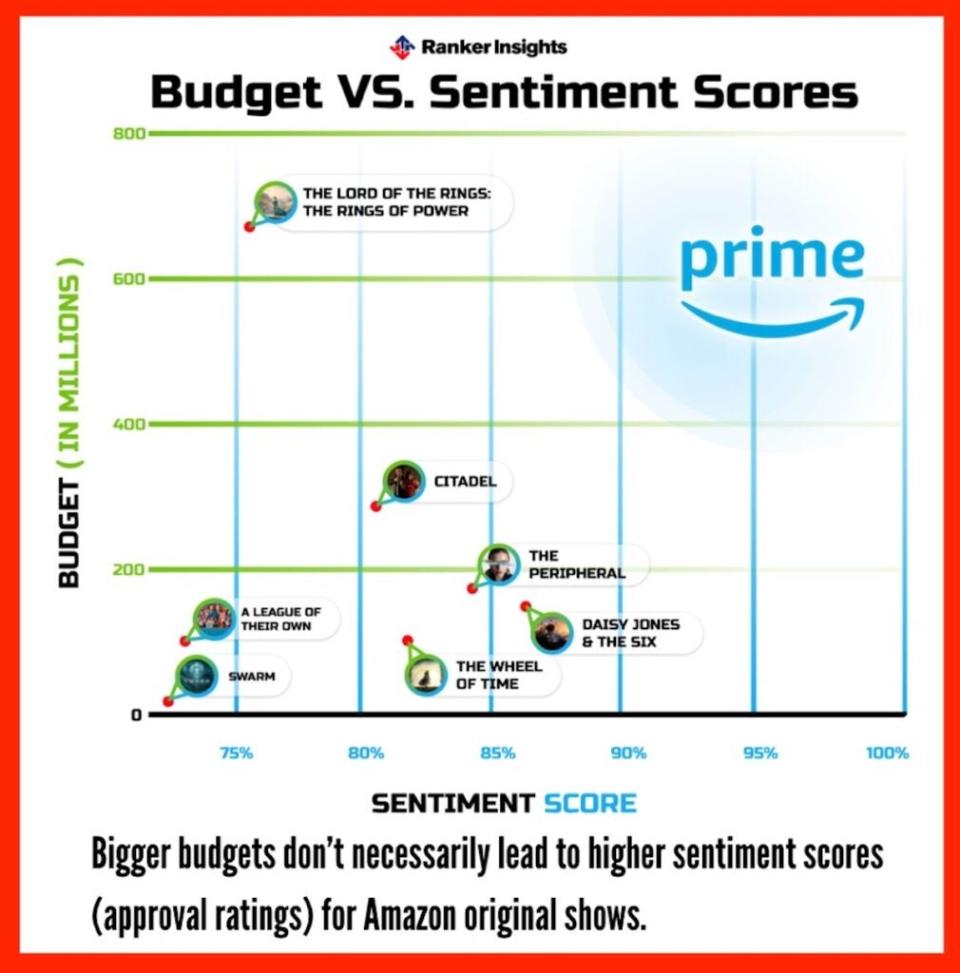Where Amazon Went Wrong in Its Push to Find a Streaming Blockbuster | Chart
At Amazon’s Prime Video, the push to find a hit show that would define the streaming service for viewers came from the very top. Prime had critical darlings like “Fleabag” and popular series like “The Boys,” but founder Jeff Bezos wanted something bigger, something that all of America would watch one night a week and talk about the other six.
As the company more than doubled its spending on original TV content between 2016 and 2019, Bezos gave his team of executives a simple directive: “I want my ‘Game of Thrones.’”
Prime Video’s content budget hit $16.6 billion in 2022, and this year, it’s predicted to reach $20 billion even as the competition tightens spending. The search for a “Game of Thrones” yielded epic fantasies “The Wheel of Time” and “Lord of the Rings” prequel “The Rings of Power,” as well as high-concept sci-fi shows like “Citadel” and “The Peripheral.” Amazon executives have defended the strategy and say it’s delivering. But reports say that inside the company, there’s a sense of frustration with the failure of these shows’ huge budgets to translate into huge audiences.
Data from Ranker Insights confirms the sense that Prime Video’s most costly shows are being outperformed. And not by competing streamers: Rather, Amazon’s most expensive series are failing to measure up to other Prime originals — shows that are more straightforward and often less pricey.
Watchworthy, Ranker’s TV recommendation app that harvests TV data for Insights, allows users to rate shows positively or negatively. The ratio of positive to negative actions taken on a given show gives it a sentiment score, much like an approval rating.
Since it premiered back in September 2022, “ The Rings of Power” garnered a sentiment score of 76%, a pretty middling reception when you consider that Amazon spent $715 million trying to attract an audience of diehard fans. The Amazon original horror series “Swarm” has a similar sentiment score of 71%, despite having a budget that amounts to less than 5% of what Amazon spent for “Rings of Power.”
“Citadel” has a similar problem. The futuristic spy thriller’s budget ballooned to $300 million when creators Joe and Anthony Russo replaced the showrunner and made changes to the script that required extensive reshoots. Despite the lengths producers went to in refining the show, our data tells us that less than 81% of viewers came away with a positive opinion. That’s fine for your average show, but not for the second most expensive series your studio has ever produced.

Amazon has kept mum about how much money it’s invested in teen romance show “The Summer I Turned Pretty.” With nine different Taylor Swift songs in the soundtrack of the second season alone, the music rights likely add up. But given that the show relies mostly on unknown actors and doesn’t involve the same kind of special effects or costume budgets required by science fiction and fantasy shows, there’s reason to believe it was a good deal less expensive to produce than “Citadel.”
Ranker’s data says fans feel far more positively about “Summer” than any of the Prime originals we’ve covered so far, giving it an incredible sentiment score of 92%. In July, when its second season premiered, sentiment spiked as high as 98%. And the audience for this show isn’t just passionate, it’s huge. In July and August, “The Summer I Turned Pretty” was added to more than three times as many watchlists on the Ranker app as “Game of Thrones,” four times as many as “Rings of Power,” and five times as many as Disney’s most recent Marvel series, “Secret Invasion.”
Similarly, Australian melodrama “The Lost Flowers of Alice Hart” debuted in August to a sentiment score of 93%. “Reacher,” Amazon’s no-nonsense action series that debuted in 2022, has a score of 87%. Even “Daisy Jones & the Six,” whose price tag rose to $140 million in part due to the challenge of staging concert scenes with COVID protocols, has an 87% sentiment score, notably higher than “Citadel” despite costing half the money.
From Amazon’s perspective, winning over viewers isn’t necessarily the top priority. The retail giant’s business model all but guarantees a significant number of subscribers who want access to faster shipping and other Prime perks. Bezos’ desire for a blockbuster was, more than anything, a desire to solidify Prime Video’s status as a major competitor in the streaming wars and to give it a prestige pedigree similar to that of HBO or Netflix.
But there’s more than one way to build a brand. “The Summer I Turned Pretty” and “Reacher” may not have the kind of mass appeal that made “Game of Thrones” the topic of watercooler conversation, but taken together, they engage huge and passionate audiences. Rather than being all things to all people, Amazon is already finding success through the diversity of its programming. It may ultimately find this approach to be more effective — and certainly more affordable — than mimicking its competitors.
Ryan Mach is a content marketing manager at Ranker, a WrapPRO partner. For more from Ranker, visit the Data and Analysis Hub.
The post Where Amazon Went Wrong in Its Push to Find a Streaming Blockbuster | Chart appeared first on TheWrap.


